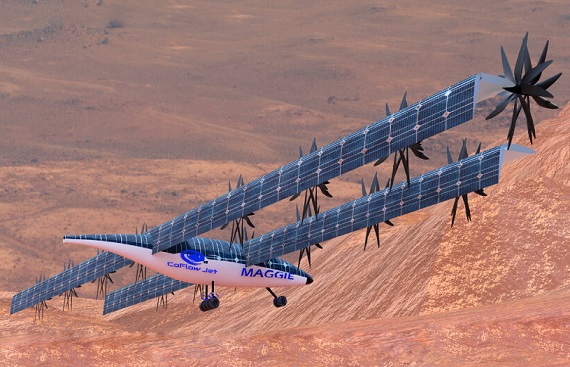NASA Unveils Solar-Powered Aircraft Concept for Mars Exploration
By
siliconindia | Tuesday, 23 January 2024, 04:13 Hrs

NASA, the United States' space agency, has put forth plans for the creation of a novel Mars exploration platform. The Mars Aerial and Ground Intelligent Explorer (MAGGIE) is designed as a compact, fixed-wing aircraft that utilizes solar energy for efficient exploration of the Red Planet. This innovative vehicle boasts ultra-high productivity efficiency, enabling it to navigate the Martian atmosphere.
It will have vertical take-off/landing (VTOL) capability, enabled by advanced deflected slipstream technology with CoFlow Jet (CFJ). "MAGGIE would be able to perform the first global-scale atmospheric mission at Mars and revolutionize our capability of exploring almost the entirety of the Martian surface. It is the first concept to enable ongoing exploration of this region of Mars and would provide a substantial leap in capability for NASA’s exploration of the Red Planet", the agency said in a statement.
The appeal of aerial missions on Mars has been well showcased by the Ingenuity helicopter, which touched down on the Red Planet in February 2021, almost three years ago, affixed to the underbelly of NASA's Mars Perseverance rover. Initially assigned the mission of conducting only five test flights to validate its groundbreaking technology, the Ingenuity helicopter surpassed all predictions by completing its 72nd flight on the Martian surface.
"MAGGIE would be similarly engaging to the public, both in its audacity, and in the variety of environments it could explore, study, and image. The technology would also enhance VTOL aircraft technology on Earth and other planets", NASA said.
The aircraft will be able to overcome the low density of the Martian atmosphere with a magnitude higher than conventional subsonic aircraft. The range of MAGGIE for a fully charged battery per 7.6 sol is 179 km at an altitude of 1,000 m. The total range of MAGGIE per Martian year is 16,048 km. The representative mission for MAGGIE presented would conduct three atmospheric and geophysical investigations.
These encompass an examination of the Martian core dynamo's origin and timing through the analysis of weak magnetic fields present in sizable impact basins. Additionally, there is a regional inquiry into the origin of methane signals identified by the Tunable Laser Spectrometer on the Mars Science Laboratory situated in Gale Crater. Moreover, there is a focus on high-resolution mapping of subsurface water ice in mid-latitudes, where such ice has been observed from orbit. NASA has stated that the preliminary study of the conceptual MAGGIE system suggests feasibility, but further investigation, design, and verification under Martian atmospheric conditions are required in Phase I.
